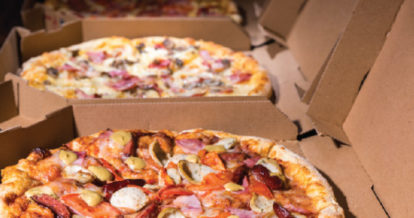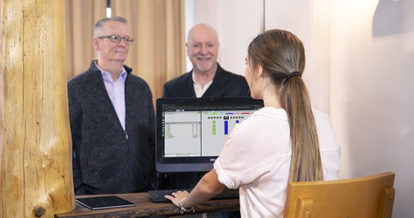Imagine this: You order your favorite meal online from a local restaurant, and thirty minutes later it arrives…cold.
How do you feel?
If you’re ravenous, you may eat it. But chances are you’ll probably feel unhappy about the entire experience. Will you be rushing to order from that restaurant again?
Probably not.
For the restaurateurs on the other end of this equation, the best way to resolve this kind of scenario is to start with proper packaging. The right restaurant food packaging helps keep your food warm, intact, and ready-to-eat from your kitchen all the way to your diner’s door.
However, food packaging isn’t only about practicality. It’s also about safety. In the wake of COVID-19, many restaurants closed their dining rooms and pivoted to takeout and delivery, using tools like TouchBistro Online Ordering to keep both staff and customers safe. In fact, since the pandemic hit in March of 2020, online ordering rose by more than 25%, with 78% of consumers ordering online as frequently or more often than before.
And among those ordering takeout and delivery, 84% agree that packaging is an important consideration when placing an order. For restaurants – especially those that just added an online ordering system – this means that the right takeout packaging is absolutely essential to getting customers and keeping customers.
The tricky part is, there are several factors to consider when choosing your restaurant food packaging.
In this post you’ll learn:
- Why it’s important to make smart decisions about restaurant food packaging (hint: packaging offers many benefits you cannot ignore)
- What factors to take into account when you create your packaging, including materials, cost, safety concerns, food packaging trends, and your brand identity
Ready? Let’s get started.
Why It’s Important to Make Smart Decisions About Restaurant Food Packaging
Packaging offers many benefits. To realize these benefits, you need to take the time to choose packaging that’s right for your business. The right packaging:
Protects Against Cross-Contamination
In a restaurant, cross-contamination is the transfer of bacteria or other harmful microorganisms from food, equipment, or people, to food. This can happen during any stage of food production, including the packaging of food for takeout and delivery. Proper food packaging, such as tamper-proof containers, keeps food safe from any cross-contamination that might occur when during the transfer of food from a restaurant to the customer – something that’s especially important in slowing the spread of the novel coronavirus.
Makes Food More Appealing
Many senses influence how we enjoy the dining experience, including our sight (i.e. how a dish looks when it arrives). The right packaging keeps food intact and upright so it arrives looking as enticing as it would in a restaurant. Just think about how much more appealing takeout sushi is when all the rolls are sitting right-side-up versus when they all get smushed together.
Controls the Temperature
There’s nothing worse than ordering soup, pizza, or pasta only to have it arrive cold. In fact, 60% of diners consider the quality, freshness, and temperature of their food to be “the most critical factor in ordering delivery.” Ideally, hot and cold food should be packaged separately so that each dish arrives at the temperature it’s meant to be enjoyed at.
Helps Sell More Food
People also buy with their eyes, and attractive packaging encourages repeat sales. In fact, one survey found that 72% of American consumers say that packaging design influences their purchasing decisions. Just think about the hype surrounding Starbucks’ holiday cup designs each year.
Allows You to Charge a Premium
Well-packaged food has a higher perceived value. As one study found, nearly a quarter of consumers are willing to pay up to 20% more for products with eco-friendly packaging.
Reinforces Your Brand Identity
Packaging is another brand touch point that helps you connect with customers through the smart use of color, design, and copy. If your restaurant is known for having a quirky sense of humor, you could create packaging that reflects this unique brand personality.
Showcases Your Values
Whether it’s a commitment to sustainability or you’re trying to raise awareness for important social issues, your packaging can convey what your restaurant values. For instance, biodegradable packaging is an easy way to show your customers that you’re committed to protecting the environment.
Factors That Will Inform the Choice Of Packaging at Your Restaurant
Now that you have a basic understanding of what the right packaging can do for your restaurant, let’s look at several factors that will inform your design: the choice and cost of material, safety concerns, food packaging trends, and your brand personality.
The Choice Of Materials and Cost
Choosing the right materials is the first step in selecting the right restaurant food packaging. There are a variety of materials available, such as plastic, cardboard, and styrofoam, as well as biodegradable and sustainable alternatives. Each has its own pros and cons:
- Styrofoam is a fantastic insulator that helps to control the temperature of hot and cold foods. Though it’s inexpensive, it’s also bad for the environment.
- Plastics are strong and offer excellent protection for food. However, plastics also hold moisture well, which can quickly lead to soggy dishes. And again, plastics are not very environmentally friendly.
- Aluminum/foil has the advantages of being durable, sealable, and non-absorbent. It also holds heat well, making it perfect for foods like burritos and grilled sandwiches. The downside is that the material is not microwavable and on the expensive side.
- Paper/cardboard is biodegradable, cost-effective, easy to customize printing, and sturdy when folded correctly. Many restaurants offering pizza delivery use corrugated cardboard boxes that provide heat insulation and regulate temperature. The box closes firmly to minimize the amount of heat that’s released and has small holes on the side, allowing some air to escape. This prevents condensation and saves the pizza from getting soggy.
- Sustainable packaging alternatives, such as sugarcane and bioplastics, are often more costly, but far better for the environment. Kore Kitchen, a meal delivery service in Los Angeles, uses recyclable glass bottles for its smoothies and compostable containers made from bagasse (a byproduct that remains after sugarcane processing).
Based on the above, it’s clear there’s no one right answer when it comes to restaurant food packaging. In fact, certain dishes on your menu may require more than one type of packaging to preserve the quality of the ingredients in transit. For instance, that clam chowder may travel well in a styrofoam cup, but the sourdough croutons may require a separate plastic bag.
If you recently added online ordering software or had to make some major menu adjustments due to COVID-19, this chart from Tundra Restaurant Supply recommends the proper packaging for each type of meal. It’s a good place to start when working out what food packaging you need to support your restaurant delivery service and takeout offerings.

Safety Concerns
Choosing the right restaurant food packaging also means taking food safety and hygiene into account. And with the treat of COVID-19 still hanging over restaurants, food safety is more important than ever before.
The good news? The CDC says that there is “no evidence of food, food containers, or food packaging being associated with the transmission of COVID-19.” The bad news is that the virus that causes COVID-19 can survive on surfaces like takeout containers. While the risk of transmission from food packaging is incredibly unlikely, experts still recommend that restaurants take extra packaging precautions.
To ensure that your packaging is safe for customers, consider the following recommendations:
- Observe existing food safety practices for time/temperature control, preventing cross-contamination, hand-washing, no sick workers, and storage of food, etc.
- Increase the frequency of cleaning and disinfecting of high-touch surfaces, including the areas where foods are packaged for takeout and delivery.
- Suitable utensils such as deli tissue, spatulas, tongs, single use-gloves, or dispensing equipment should be used when handling ready-to-eat foods.
- Use disposable containers and packaging whenever possible.
- Properly clean, sanitize, and disinfect coolers and insulated bags used to deliver foods.
- Add tamper-evident labels (a ripped label alerts the customer that the order was tampered with) or use tamper-proof boxes for deliveries.
- Add a note to each takeout and delivery order with instructions on how to safely handle food and packaging before eating. Suggest that customers remove the food from the original takeout bags or containers, and dispose of or recycle them appropriately. After disposing of the packaging, customers should wash their hands with soap and water for at least 20 seconds. Finally, counters or any other surfaces where the food was unpacked should be wiped down.
Though it may be tempting to stick with the packaging you used before the pandemic, you can’t offer the best food delivery service unless you recognize that some items just won’t cut it when it comes to food safety. For instance, reusable bags and mugs, and have been banned by many restaurants and cafes due to hygiene concerns.
And while the risk of transmission is small, consumer anxiety around food safety is big. In fact, a poll by G&S Business Communications showed that 69% of Americans are more concerned about food safety than they were a few months ago and 44% of Americans say they now clean their food packaging with a disinfectant.
Even if the changes you make are only temporary, taking extra packaging precautions can help ease diners’ worries by showing them you take their safety seriously.
Food Packaging Trends

Here are four of the most significant trends to consider when creating or redesigning packaging.
1. Sustainable Packaging
Prior to the COVID-19 pandemic, growing awareness of environmental issues led to customers placing increased pressure on companies and restaurants to be totally transparent about the products they sell.
Though COVID-19 has put some environmental concerns on the backburner, understanding a food’s origin is still one of the hottest food trends. Customers want to know where it came from, what’s in it, and how it’s made. With increased pressure on corporate social responsibility, customers are less forgiving of companies who don’t share their values.
And it’s not just about food anymore. Customers want restaurants to embrace sustainable packaging practices too. According to a survey by Asia Pulp & Paper, nearly two-thirds of Americans demand sustainable packaging and clear labeling.
This means that single-use plastics and anything that can’t be recycled is a no-no. Instead, biodegradable, eco-friendly, and even edible packaging is in. Many restaurants are already following suit, with McDonald’s announcing they would ditch foam packaging in 2018 and Starbucks testing greener coffee cups that are both recyclable and compostable.
The bottom line?
Sustainable packaging can help you win over customers who support environmentally conscious brands. On the flip side, fail to adopt sustainable practices and you might feel the wrath of customers who care deeply about these issues.
2. Minimalistic Packaging
The minimalism trend is present everywhere: Clean and simple websites, book covers with less clutter, and yes, you guessed it, packaging that’s free from unnecessary materials and cluttered designs.
Burger King was one of the first big restaurant brands to embrace this pared-down aesthetic, by rebranding its takeout packaging with more modern, minimalistic designs. McDonald’s and other brands quickly followed suit, stepping away from cluttered designs with multiple colors and fonts.
But what’s driving this trend?
There are many factors:
- Minimalistic packaging embraces a no-nonsense, no-frills approach.
- It’s material savvy, cost-effective, and often, environmentally friendly.
- It helps brands create and reinforce an upscale image, which increases the perceived value of the brand.
- With less clutter clouding the message, the brand can better communicate their core message and increase awareness with customers.
To remain ahead of the curve, remove any irrelevant information and graphics from your packaging, and only include the essentials.
3. Personalized Packaging
To stay ahead of the competition, many brands are personalizing their packaging.
The rise of this trend isn’t surprising. Personalization offers many benefits for companies, It helps restaurant staff learn the names of regulars, creating stronger, more emotional connections with customers. If the packaging is shared on social media, it also gives restaurants free word-of-mouth marketing.
Personalization also provides “a nice touch” that ensures companies remain top-of-mind with customers. Wouldn’t you feel special if you received a personal note every time you ordered food?
As a restaurateur, you could print personal messages on your to-go items that make customers feel special. Simply leave a space on the packaging and then write a small note that reads “Made with love for [insert customer name] by [insert server name].”
Though personalization may not have made a significant difference in the past, it will be a game-changer in the wake of COVID-19. With most people now using a restaurant online ordering system to pick up pre-packaged meals instead of dining-in, brands have fewer opportunities to communicate with their customers. Personalized packaging offers one of the few opportunities to speak directly to customers ordering takeout and delivery, and show them how much they’re appreciated.
4. Convenient Packaging
Customers today have busy lifestyles that demand convenience.
That need for convenience has a big impact on restaurant takeout. Customers are buying the convenience of ordering and eating food on the go, or in the safety and comfort of their own home – without having to cook or do dishes.
This means your food delivery packaging needs to be designed with convenience in mind. It should be lightweight, easy to carry, and resealable (so it doesn’t need to be eaten all in one go).
For example, if you’re a restaurant that specializes in noodles, your takeout might have a convenient handle at the top. Or, if you focus on sandwiches, do what Eat&Go did and offer accordion takeout tubes that inch smaller and smaller as you eat. The end result is something that fits in the customer’s pocket.
Brand Personality
If you’re stumped on how to market your restaurant, takeout packaging is one of the best places to start. This is especially true now that consumers are increasingly ordering through third-party apps, instead of directly from restaurants.
By including your branding on your takeout packaging, you’re helping the customer associate the food they’re eating with your specific restaurant (and not with the best food delivery app). And with stronger brand recognition, that customer is more likely to order directly from your restaurant in the future.
At a bare minimum, you should be including your company name or logo on the packaging so that your brand is visible to anyone who sees it.
But there are more opportunities here than just slapping some logos on a takeout box.
As mentioned right at the beginning, packaging provides yet another touch point for customers to interact with your brand. Your food packaging shows customers what you care about and, by extension, what you don’t.
That means your packaging is an extension of your brand and should be designed with your brand personality in mind. Ask yourself:
- Do the materials you’re using align with your brand?
- Do the visuals and information on the packaging properly communicate your brand identity?
- Does the packaging speak to your audience?
- Does your packaging include relevant information (ie. your website or social media handles)?
Answering these questions can help you figure out if your packaging will have a positive or negative impact on your brand.
Because We All Judge a Book by Its Cover
From protecting your food from harmful germs, to helping promote your brand, restaurant takeout packaging offers many benefits for your business.
But in order to reap these benefits, you’ve got to make smart decisions about your packaging from the start. This means selecting the right materials, embracing the latest trends, using strategic branding, and prioritizing health and safety.
The only remaining question is, will you make smart decisions about food packaging at your restaurant?

Let your customers know how to order takeout and delivery from you.
Free online ordering signs for your restaurant
Sign up for our free weekly TouchBistro Newsletter







